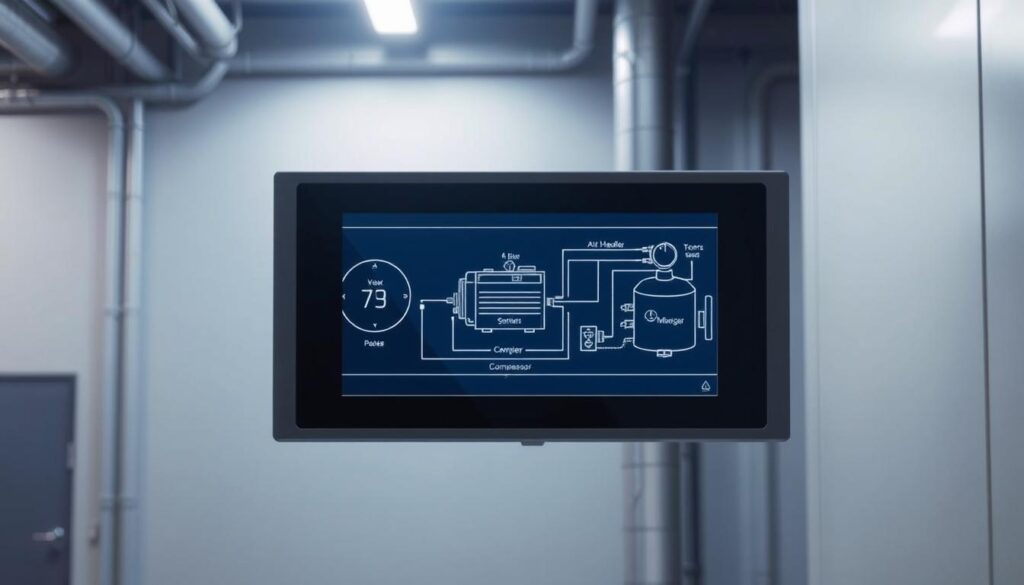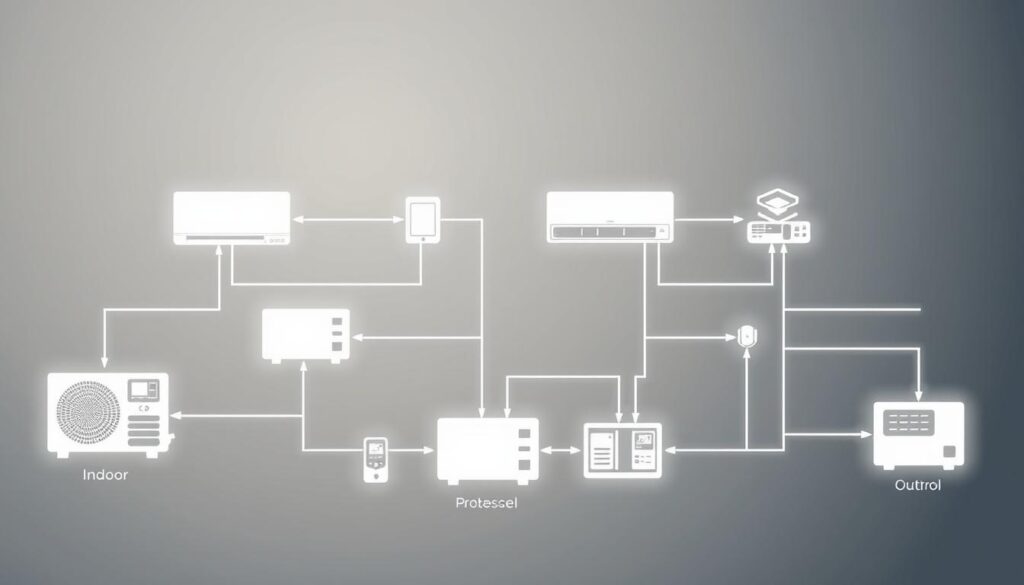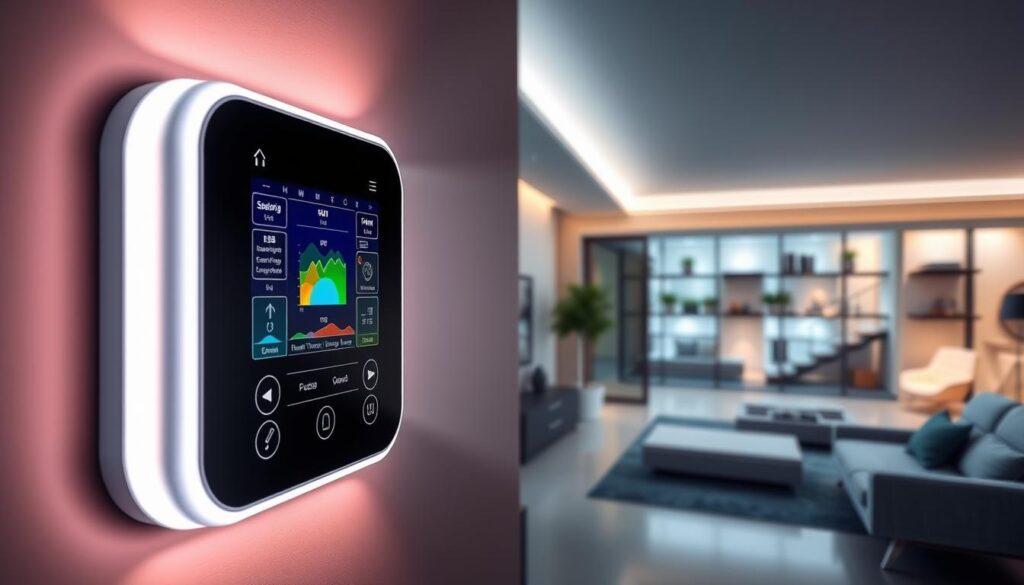Affiliate Disclosure
HVAC Guide Guys is a participant in the Amazon Services LLC Associates Program, an affiliate advertising program designed to provide a means for sites to earn advertising fees by advertising and linking to Amazon.
How Do Communicating HVAC Systems Work? Ever wondered how modern HVAC systems can guess and meet your comfort needs before you even ask? What if your heating and cooling system could talk to you, saving energy and keeping your home just right?

Communicating HVAC systems are a big step forward in controlling your home’s climate. They use smart parts that work together smoothly. This means they can work better and use less energy, making your home more comfortable.
The tech behind HVAC zone control lets these systems adjust to different parts of your home. This gives you comfort where you need it most while saving energy. Modern systems can cut energy costs by up to 30% when paired right, making them a wise choice for smart home management.
Key Takeaways
- Communicating HVAC systems offer unprecedented energy efficiency
- Smart technology enables precise temperature and humidity control
- Zone control allows personalized comfort in different home areas
- Advanced systems can extend equipment lifespan by 10-15 years
- Real-time monitoring prevents performance degradation
- Integration of multiple components increases overall system performance
Table of Contents
Understanding the Basics of Integrated HVAC Systems
Modern HVAC systems have evolved from simple devices to complex networked systems. They now manage indoor climate in a smart and efficient way. These systems combine different parts to create environments that are both comfortable and energy-saving.
Core Components of Modern HVAC Integration
Integrated HVAC systems need several key parts to work well:
- Smart sensors for real-time environmental monitoring
- Advanced controllers with predictive algorithms
- Wireless communication modules
- Network-enabled actuators and dampers
The Evolution of HVAC Communication Technology
HVAC wireless communication has greatly improved system capabilities. It has moved from old hardwired systems to modern wireless networks. This change brings more flexibility and control to HVAC technology.
“The future of HVAC is intelligent, connected, and responsive to real-time environmental conditions.”
Benefits of System Integration
| Benefit Category | Performance Improvement |
|---|---|
| Energy Efficiency | Up to 30% reduction in energy consumption |
| Operational Cost | 25-50% possible cost savings |
| System Performance | 20-30% better efficiency |
| Maintenance Downtime | 70% less downtime with predictive strategies |
By using integrated HVAC technologies, you can make your space smarter. It will adapt to your needs, saving energy and keeping you comfortable.
Explore Our HVAC Shop
Looking for top-rated HVAC tools, parts, and accessories? Visit our shop and find the perfect solution for your needs.
Visit the ShopHow Do Communicating HVAC Systems Work
Communicating HVAC systems are advanced networks that make your home more comfortable and energy-efficient. They are different from old systems because they talk to each other to adjust the climate. This means your home stays just right, all the time.
These smart systems use sensors and electronic controllers to work. They have:
- Multi-wire communication protocols connecting different system components
- Electronic sensors replacing older mercury-based temperature monitors
- Computer chips enabling real-time system adjustments
The tech in these systems lets them control heating, cooling, and fans precisely. They use up to 12 control wires to talk between indoor and outdoor units. This lets them share detailed information.
“Modern HVAC systems are not just temperature controllers, but intelligent climate management networks.” – HVAC Technology Experts
Your communicating HVAC system does a lot:
- It checks how well it’s working all the time.
- It optimizes energy use in real-time.
- It sends you reminders for maintenance.
- It improves how well it removes moisture.
Even though these systems are more expensive and harder to install, they save money. You could cut your energy bills by 10-20% each year.
Explore Our HVAC Shop
Looking for top-rated HVAC tools, parts, and accessories? Visit our shop and find the perfect solution for your needs.
Visit the ShopSmart Thermostat Communication and Control
Modern HVAC control integration has changed home comfort with smart technology. Smart thermostats lead in hvac building automation, changing how we control our home’s climate.
Today’s smart thermostats offer unmatched control and efficiency. They do more than just set temperatures. They adapt to your lifestyle with advanced features.
Wi-Fi Enabled Temperature Control
Wi-Fi thermostats let you control your home’s temperature from anywhere with your smartphone. The benefits are:
- Remote temperature adjustments
- Real-time system monitoring
- Energy consumption tracking
Geofencing and Automated Adjustments
Geofencing technology uses your smartphone’s GPS for automatic temperature adjustments. Imagine your home cooling down as you approach or warming up before you arrive.
“Smart thermostats are transforming HVAC systems from static appliances to intelligent, responsive networks.” – HVAC Technology Insights
Real-Time Monitoring Capabilities
Advanced smart thermostats offer detailed monitoring. They track:
- Space temperature
- Humidity levels
- CO2 concentrations
- System performance metrics
With up to 24 different alert types, these devices give you deep insight into your HVAC system. This helps you keep your home comfortable and efficient.
Explore Our HVAC Shop
Looking for top-rated HVAC tools, parts, and accessories? Visit our shop and find the perfect solution for your needs.
Visit the ShopHVAC System Connectivity and Network Architecture
Modern HVAC systems use smart technologies to connect. These systems change how buildings control temperature, air quality, and energy use. They use complex communication to work together smoothly.

At the heart of HVAC systems is the ability to share data in real-time. Smart devices talk to each other through various ways, including:
- Wireless protocols like Wi-Fi and Zigbee
- Wired communication networks
- Internet of Things (IoT) platforms
- Advanced sensor technologies
Each type of network has its own benefits for HVAC systems. Smart sensors send detailed info on temperature, humidity, and energy use.
“The future of HVAC is not just about cooling or heating, but intelligent, responsive environmental management.” – HVAC Technology Expert
Knowing how HVAC networks work helps improve performance and save energy. BACnet protocols, for example, let different parts of the system talk to each other. This makes it easier to monitor and control everything.
| Network Type | Communication Speed | Primary Use |
|---|---|---|
| BACnet MS/TP | 0.1 MB per second | Serial communication |
| BACnet IP | 100+ MB per second | Internet protocol communication |
Strong HVAC system connections can lead to big energy savings. Buildings could cut energy use by up to 25 percent.
Building Automation and System Integration
HVAC building automation changes how we manage indoor spaces. It uses advanced tech to make buildings smarter and more energy-efficient. This approach optimizes comfort and cuts down on energy use.
Today’s buildings need smart solutions, not just basic HVAC control. Advanced control systems bring unmatched efficiency and performance.
Central Control Systems
Central control systems are the heart of HVAC remote monitoring. They manage many building systems through networks.
- Centralize multiple building operations
- Enable real-time system adjustments
- Provide detailed performance tracking
Remote Monitoring Solutions
Remote monitoring changes how facility managers work with HVAC systems. Now, you can control and monitor buildings from anywhere in the world.
“Integration centralizes functioning, allowing automatic alterations based on user preferences and available data.” – Building Automation Expert
Data Collection and Analysis
Data is key to better HVAC performance. With advanced tracking, you can:
- Collect real-time performance metrics
- Spot system inefficiencies
- Plan for maintenance
The Department of Energy says HVAC uses 44% of energy in commercial buildings. Advanced building automation could cut energy use by up to 30%.
Integrating HVAC with building automation boosts system performance and energy efficiency. It also lowers costs. Your indoor spaces become more sustainable, comfortable, and smart.
Explore Our HVAC Shop
Looking for top-rated HVAC tools, parts, and accessories? Visit our shop and find the perfect solution for your needs.
Visit the ShopEnergy Efficiency Through Advanced Communication

Smart HVAC management has changed how we save energy in our homes. These systems use advanced communication to control and save energy better. They let homeowners manage their home’s climate in new ways.
The main benefits of hvac zone control are:
- Precise temperature management across different home areas
- Real-time performance monitoring
- Automated energy-saving adjustments
- Reduced utility costs
“Communicating HVAC systems are not just about comfort—they’re about intelligent energy management.”
These systems can analyze lots of data to work better. For example, they use sensors to know when people are home. This helps control the temperature more efficiently.
| Feature | Energy Savings |
|---|---|
| Remote Diagnostics | Up to 20% less in maintenance costs |
| Smart Thermostat Integration | 10-15% lower utility bills |
| Predictive Maintenance | System lasts 3-5 years longer |
Modern HVAC systems run quieter and use less energy. They also come with longer warranties, showing they’re reliable.
The future of home climate control is here—intelligent, responsive, and environmentally conscious.
Troubleshooting and Maintenance of Communicating Systems
Maintaining modern HVAC systems needs a smart plan. This plan uses advanced hvac remote monitoring tech. These systems need regular care to work well and last long.
Communicating HVAC systems are complex. They have up to 12 control wires, unlike traditional systems. This makes them more prone to technical issues.
Common Technical Issues
- Connection disruptions between system components
- Sensor communication failures
- Intermittent wireless communication problems
- Software synchronization errors
Preventive Maintenance Strategies
Keeping your hvac system in top shape involves several steps:
- Regular system diagnostics
- Firmware updates
- Comprehensive sensor calibration
- Professional annual inspections
| Maintenance Action | Potential Benefit | Frequency |
|---|---|---|
| Sensor Cleaning | Improve Accuracy | Quarterly |
| Firmware Updates | Enhanced Performance | Biannually |
| Wireless Network Check | Stable Communication | Every 6 Months |
System Optimization Tips
To get the most out of your HVAC system, try these tips:
- Use smart scheduling features
- Watch energy use patterns
- Try zoned temperature control
- Add humidity management
“Proactive maintenance can reduce emergency repair costs by up to 20% and extend system life significantly.” – HVAC Industry Expert
Knowing how to maintain your HVAC system ensures it works great. It keeps you comfortable and saves energy for years.
Explore Our HVAC Shop
Looking for top-rated HVAC tools, parts, and accessories? Visit our shop and find the perfect solution for your needs.
Visit the ShopFuture Trends in HVAC Communication Technology
The world of hvac wireless communication is changing fast. New innovations are making smart hvac management better than ever. These advancements are changing how we control and improve indoor climate systems.
New trends are bringing big changes to the HVAC industry. Some of the most exciting developments include:
- Artificial Intelligence (AI) integration for predictive maintenance
- Advanced IoT connectivity
- Machine learning algorithms for energy optimization
- 5G network-enabled communication systems
“The future of HVAC technology is not just about cooling and heating, but creating intelligent, responsive environments.”
Recent stats show how these technologies are making a big difference:
| Technology | Impact | Efficiency Improvement |
|---|---|---|
| IoT Integration | Real-time Monitoring | 20% Energy Efficiency |
| Machine Learning | Schedule Optimization | 15% Energy Reduction |
| Remote Monitoring | Predictive Maintenance | 25% Repair Cost Reduction |
Smart technologies are coming together to make HVAC systems better. Homeowners can expect unprecedented levels of comfort and control as these innovations keep improving.
The global HVAC market is expected to hit $250 billion by 2025. This growth is thanks to smart and sustainable technologies that are changing how we manage indoor climate.
Conclusion
Learning about communicating HVAC systems shows a new way to control home and business climates. These systems do more than just adjust the temperature. They are smart networks that change how we use our indoor spaces.
Smart thermostats and HVAC control integration bring new levels of energy management. They save a lot of energy. Studies show they can cut energy use by 10-30% through smart temperature settings and automatic changes.
These systems learn your habits to work better and save you money. Your HVAC system becomes smart and efficient, fitting your lifestyle and comfort needs.
Choosing modern HVAC systems is smart for comfort and saving energy. The right setup and care can save up to 47% of energy. As tech gets better, these systems will offer even more control and savings for homes and businesses.
Starting your journey with advanced HVAC tech is a wise move. It leads to smarter, more eco-friendly indoor spaces. By using these new technologies, you’re not just improving your climate control. You’re investing in a more efficient and comfortable future.

